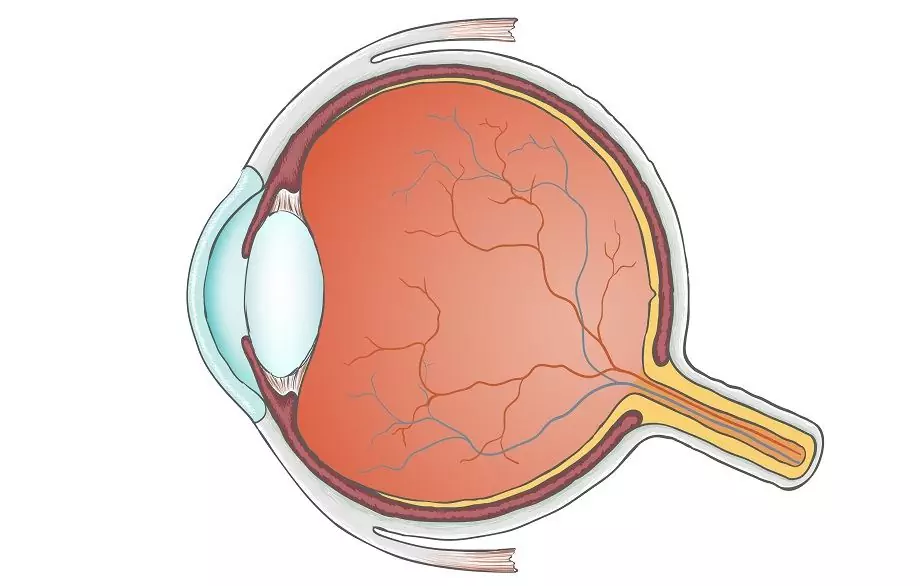- Author Rachel Wainwright [email protected].
- Public 2023-12-15 07:39.
- Last modified 2025-11-02 20:14.
Farsightedness
General characteristics of the disease

Farsightedness or hyperopia is an ophthalmic disease with impaired visual acuity when looking at nearby objects. However, with a high degree of hyperopia, a person sees distorted objects that are from him both at a distance of 20-30 cm, and further 10 m.
The disease leads to a systematic overstrain of the eye muscles, so farsighted people often suffer from headaches and visual fatigue. On average, about every second inhabitant of the Earth over 30 years old suffers from hyperopia to one degree or another. Under the age of one year and after 50 years, hyperopia is a natural state of the human visual apparatus.
Hyperopia reasons
Normally, in a well-seeing person, the image is focused on the retina, and not on the plane behind it, as is the case with hyperopia. The cause of abnormal refraction of the eyes is most often the small size of the eyeball along the anteroposterior axis. That is why hyperopia in newborns is a natural physiological phenomenon, which in most cases goes away with age.
Another possible cause of hyperopia is disturbance of the lens accommodation, its inability to correctly change the curvature. This disorder leads to a different type of disease - age-related hyperopia or presbyopia. The older the person, the worse the accommodative capabilities of his eyes, and the stronger the blurring of images of nearby objects becomes.
Types of farsightedness
In addition to natural physiological hyperopia in infants, the disease can be congenital. We are talking about those cases when the child's vision does not return to normal over time. Farsightedness of this form can be caused not only by the small size of the eyeball, but also by the weak innate refractive power of the lens or cornea.
With congenital farsightedness in children with a coefficient above 3.0 diopters, there is a high probability of developing a concomitant disease - friendly strabismus. It is caused by overstrain of the child's oculomotor muscles and the constant reduction of the eyes to the nose for greater clarity of vision. Further progression of the disease can cause an even more formidable complication of hyperopia in children - amblyopia (weakened vision of one of the eyes).
Age-related hyperopia is typical for people over 45 years old. The disease is caused by age-related changes in the muscles and tissues of the eye. The lens becomes sclerosed over time, thickens, the ciliary muscle weakens, and the eye loses its ability to refract normally.
Farsightedness is a natural condition of a person. It cannot be prevented, but the consequences of age-related farsightedness can be avoided: blurred vision, headaches and eye strain. To do this, you need to promptly start correcting hyperopia using glasses, contact techniques or surgical treatment.
Often at a young age, hyperopia acquires a latent form. The accommodative capabilities of the eyes are still great, and the person does not feel vision problems, but overstrain of the eye muscles leads to rapid eye fatigue, headache and nausea. Over time, the latent disease becomes apparent, and in case of delayed diagnosis of hyperopia in children, it threatens to turn into squint or amblyopia.
Hyperopia diagnostics
The main symptom of farsightedness is poor near vision with normal distance vision. This symptom is easily identified by an ophthalmologist during an eye examination using a Sivtsev chart with letters of different sizes, as well as through the use of minus and plus lenses.
Instrumental diagnosis of hyperopia in children and adults involves the use of a phoropter and computer autorefractometry. The optical power of the cornea is measured using keratometry, and the length of the longitudinal axis of the eye is measured by echobiometry.
Farsightedness in children and young patients is tested only in conditions of forced dilation of the pupils with atropine sulfate. This method allows you to weaken the accommodation of the eye and facilitates the diagnosis of latent hyperopia.
Conservative treatment of hyperopia
The main goal of hyperopia treatment is to change the optical power of the eye so that the image is focused on the retina, and not in the plane behind it. The most common conservative treatment for hyperopia is glasses. Farsighted people use them while reading, working at the computer, watching TV and other activities with a predominant concentration of gaze at close range.
An alternative to glasses for correcting hyperopia are contact lenses for day or night wear, made of mineral or organic materials. Unlike glasses, lenses are comfortable during sports or outdoor activities. However, they cannot be used in the treatment of hyperopia in children, and their use implies the use of special decorative cosmetics for women.
Part of the conservative treatment of hyperopia are hardware techniques to improve vision: ultrasound therapy, electrical stimulation, massaging glasses, vacuum massage, etc. In some cases, they can significantly improve vision without resorting to surgical correction of hyperopia.
Surgical correction of hyperopia

With the help of a laser, it is possible to change the abnormal shape of the cornea - one of the main causes of hyperopia. The laser beam removes a layer of eye tissue and permanently changes the curvature of light refraction, i.e. refraction.
Laser correction is one of the fastest treatments for hyperopia. The operation takes a few minutes under local anesthesia, and the patient can go home on the same day. However, as with any other type of surgery, there is a risk of postoperative complications and the need to re-correct hyperopia. Laser treatment is not used for age-related hyperopia with significantly impaired eye accommodation.
In patients with high farsightedness, it is customary to begin vision correction from the preparatory stage - sclero- or collagenoplasty. The essence of this surgical method is to create a new corset for the sclera using donor tissues. Only after the patient's disease progression stops, he is sent for laser correction of hyperopia.
With retinal thinning, as one of the complications of the disease, laser coagulation is also a preparatory stage in the surgical treatment of hyperopia. It is performed with a laser and helps to attach the retina to the fundus, preventing detachment and degeneration.
The most severe disease, including age-related hyperopia, is treated by implanting a phakic or multifocal lens inside the eye. This method of correcting hyperopia is used in cases where all other methods of treatment were ineffective.
YouTube video related to the article:
The information is generalized and provided for informational purposes only. At the first sign of illness, see your doctor. Self-medication is hazardous to health!






